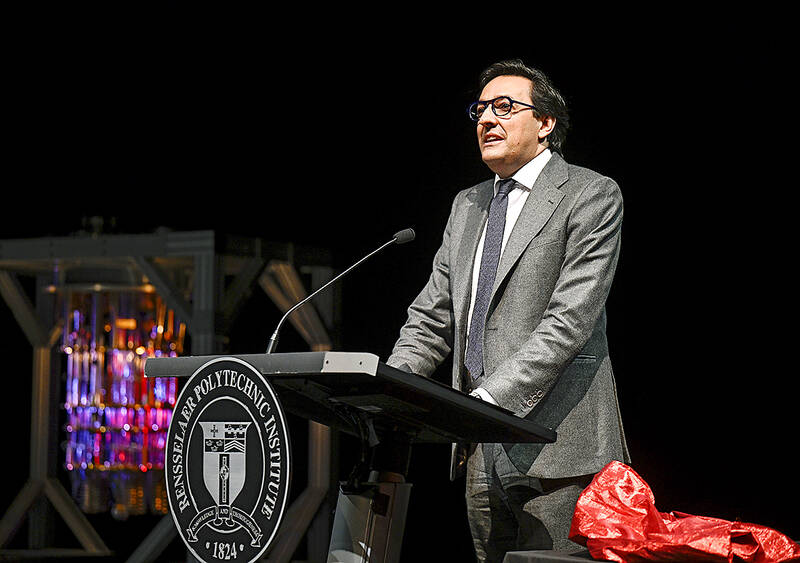Tech leaders have been vocal proponents of the need to regulate artificial intelligence, but they’re also lobbying hard to make sure the new rules work in their favor.
That’s not to say they all want the same thing.
Facebook parent Meta and IBM yesterday launched a new group called the AI Alliance that’s advocating for an “open science” approach to AI development that puts them at odds with rivals Google, Microsoft and ChatGPT-maker OpenAI.

Photo: AP
These two diverging camps — the open and the closed — disagree about whether to build AI in a way that makes the underlying technology widely accessible. Safety is at the heart of the debate, but so is who gets to profit from AI’s advances.
Open advocates favor an approach that is “not proprietary and closed,” said Dario Gil, a senior vice president at IBM who directs its research division. “So it’s not like a thing that is locked in a barrel and no one knows what they are.”
WHAT’S OPEN-SOURCE AI?
The term “open-source” comes from a decades-old practice of building software in which the code is free or widely accessible for anyone to examine, modify and build upon.
Open-source AI involves more than just code and computer scientists differ on how to define it depending on which components of the technology are publicly available and if there are restrictions limiting its use. Some use open science to describe the broader philosophy.
The AI Alliance — led by IBM and Meta and including Dell, Sony, chipmakers AMD and Intel and several universities and AI startups — is “coming together to articulate, simply put, that the future of AI is going to be built fundamentally on top of the open scientific exchange of ideas and on open innovation, including open source and open technologies,” Gil said ahead of its unveiling.
Part of the confusion around open-source AI is that despite its name, OpenAI — the company behind ChatGPT and the image-generator DALL-E — builds AI systems that are decidedly closed.
“To state the obvious, there are near-term and commercial incentives against open source,” said Ilya Sutskever, OpenAI’s chief scientist and co-founder, in a video interview hosted by Stanford University in April. But there’s also a longer-term worry involving the potential for an AI system with “mind-bendingly powerful” capabilities that would be too dangerous to make publicly accessible, he said.
To make his case for open-source dangers, Sutskever posited an AI system that had learned how to start its own biological laboratory.
IS IT DANGEROUS?
Even current AI models pose risks and could be used, for instance, to ramp up disinformation campaigns to disrupt democratic elections, said University of California, Berkeley scholar David Evan Harris.
“Open source is really great in so many dimensions of technology,” but AI is different, Harris said.
“Anyone who watched the movie Oppenheimer knows this, that when big scientific discoveries are being made, there are lots of reasons to think twice about how broadly to share the details of all of that information in ways that could get into the wrong hands,” he said.
The Center for Humane Technology, a longtime critic of Meta’s social media practices, is among the groups drawing attention to the risks of open-source or leaked AI models.
“As long as there are no guardrails in place right now, it’s just completely irresponsible to be deploying these models to the public,” said the group’s Camille Carlton.
IS IT FEAR-MONGERING?
An increasingly public debate has emerged over the benefits or dangers of adopting an open-source approach to AI development.
Meta’s chief AI scientist, Yann LeCun, this fall took aim on social media at OpenAI, Google and startup Anthropic for what he described as “massive corporate lobbying” to write the rules in a way that benefits their high-performing AI models and could concentrate their power over the technology’s development. The three companies, along with OpenAI’s key partner Microsoft, have formed their own industry group called the Frontier Model Forum.
LeCun said on X, formerly Twitter, that he worried that fearmongering from fellow scientists about AI “doomsday scenarios” was giving ammunition to those who want to ban open-source research and development.
“In a future where AI systems are poised to constitute the repository of all human knowledge and culture, we need the platforms to be open source and freely available so that everyone can contribute to them,” LeCun wrote. “Openness is the only way to make AI platforms reflect the entirety of human knowledge and culture.”
For IBM, an early supporter of the open-source Linux operating system in the 1990s, the dispute feeds into a much longer competition that precedes the AI boom.
“It’s sort of a classic regulatory capture approach of trying to raise fears about open-source innovation,” said Chris Padilla, who leads IBM’s global government affairs team. “I mean, this has been the Microsoft model for decades, right? They always opposed open-source programs that could compete with Windows or Office. They’re taking a similar approach here.”
WHAT ARE GOVERNMENTS DOING?
It was easy to miss the “open-source” debate in the discussion around US President Joe Biden’s sweeping executive order on AI.
That’s because Biden’s order described open models with the highly technical name of “dual-use foundation models with widely available weights” and said they needed further study. Weights are numerical parameters that influence how an AI model performs.
“When the weights for a dual-use foundation model are widely available — such as when they are publicly posted on the Internet — there can be substantial benefits to innovation, but also substantial security risks, such as the removal of safeguards within the model,” Biden’s order said. He gave U.S. Commerce Secretary Gina Raimondo until July to talk to experts and come back with recommendations on how to manage the potential benefits and risks.
The European Union has less time to figure it out. In negotiations coming to a head Wednesday, officials working to finalize passage of world-leading AI regulation are still debating a number of provisions, including one that could exempt certain “free and open-source AI components” from rules affecting commercial models.

The Democratic Progressive Party (DPP), Chinese Nationalist Party (KMT), and the country’s other political groups dare not offend religious groups, says Chen Lih-ming (陳立民), founder of the Taiwan Anti-Religion Alliance (台灣反宗教者聯盟). “It’s the same in other democracies, of course, but because political struggles in Taiwan are extraordinarily fierce, you’ll see candidates visiting several temples each day ahead of elections. That adds impetus to religion here,” says the retired college lecturer. In Japan’s most recent election, the Liberal Democratic Party lost many votes because of its ties to the Unification Church (“the Moonies”). Chen contrasts the progress made by anti-religion movements in

Taiwan doesn’t have a lot of railways, but its network has plenty of history. The government-owned entity that last year became the Taiwan Railway Corp (TRC) has been operating trains since 1891. During the 1895-1945 period of Japanese rule, the colonial government made huge investments in rail infrastructure. The northern port city of Keelung was connected to Kaohsiung in the south. New lines appeared in Pingtung, Yilan and the Hualien-Taitung region. Railway enthusiasts exploring Taiwan will find plenty to amuse themselves. Taipei will soon gain its second rail-themed museum. Elsewhere there’s a number of endearing branch lines and rolling-stock collections, some

Last week the State Department made several small changes to its Web information on Taiwan. First, it removed a statement saying that the US “does not support Taiwan independence.” The current statement now reads: “We oppose any unilateral changes to the status quo from either side. We expect cross-strait differences to be resolved by peaceful means, free from coercion, in a manner acceptable to the people on both sides of the Strait.” In 2022 the administration of Joe Biden also removed that verbiage, but after a month of pressure from the People’s Republic of China (PRC), reinstated it. The American

Chinese Nationalist Party (KMT) legislative caucus convener Fu Kun-chi (傅?萁) and some in the deep blue camp seem determined to ensure many of the recall campaigns against their lawmakers succeed. Widely known as the “King of Hualien,” Fu also appears to have become the king of the KMT. In theory, Legislative Speaker Han Kuo-yu (韓國瑜) outranks him, but Han is supposed to be even-handed in negotiations between party caucuses — the Democratic Progressive Party (DPP) says he is not — and Fu has been outright ignoring Han. Party Chairman Eric Chu (朱立倫) isn’t taking the lead on anything while Fu